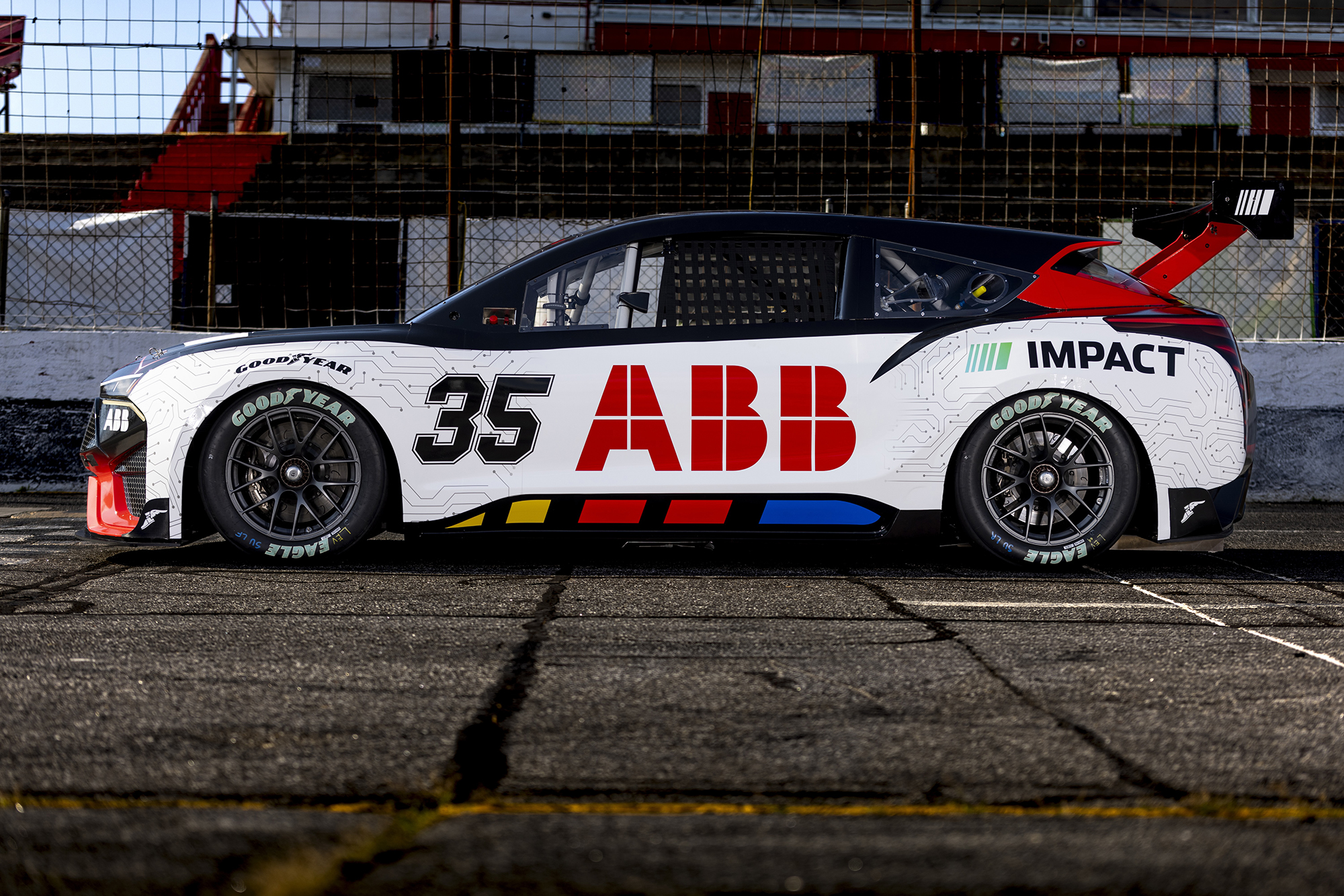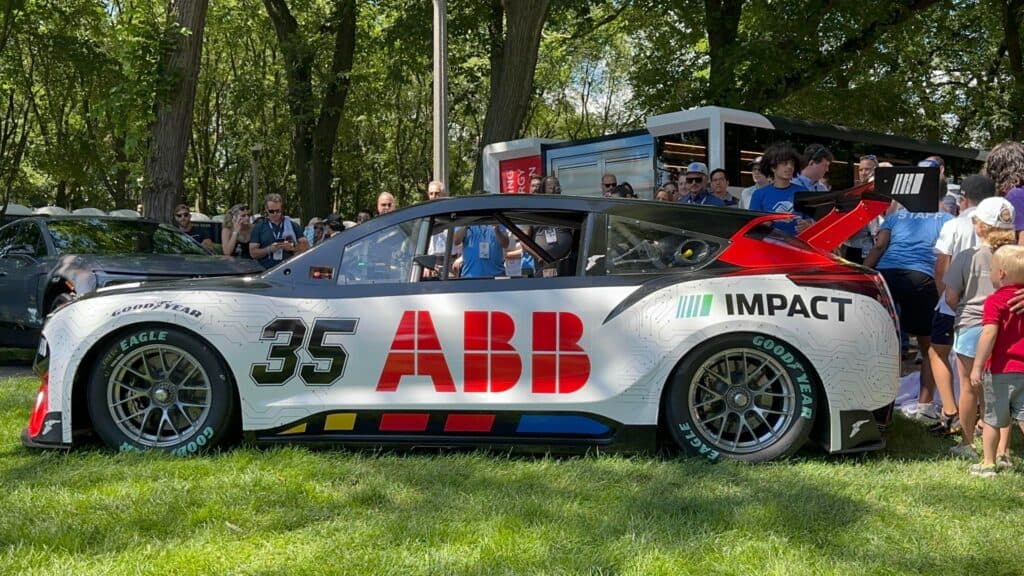By Jerry Jordan, Editor
NASCAR’s long-awaited EV racecar is now a reality, debuting Saturday morning at the Chicago Street Race event after two years of development and testing. But don’t expect to see it on the track any time soon, if ever.
The prototype car and the initiative by NASCAR are part of a broader plan, known as NASCAR IMPACT, to create ways for the stock car industry to find improvements in vehicle electrification and charging capabilities. It was originally to be debuted at The Clash earlier this year, but torrential rains delayed those plans. However, the car did turn a few laps at The LA Coliseum.
News of NASCAR’s work on an EV racecar was first reported by Kickin’ the Tires in July 2022, but the sanctioning body kept the reveal under wraps until announcing the partnership with innovations and technology company ABB. The company is the first official partner of NASCAR IMPACT, which is NASCAR’s zero-carbon initiative endeavor and joins Xfinity, McDonald’s, Blue Cross and Blue Shield of Illinois as a founding partner of the Chicago Street Course Race Weekend.
ABB and NASCAR want to use the partnership to showcase energy transition and help educate fans about electric vehicles and other forms of alternative vehicle propulsion. Explained to Kickin’ the Tires in simplest terms, the project was an effort to see if NASCAR’s design and build team, which created the Garage 56 entry raced at Le Mans in 2023, along with input and collaboration from all three current manufacturers, could create an electric vehicle with the possibility of expansion for other forms of alternative energy vehicles, like hybrid technology and internal combustion, hydrogen-fueled engines.
“ABB is a technology leader in electrification and automation, and we help customers globally to optimize, electrify and decarbonize their operations,” said Ralph Donati, ABB Executive Vice President. “The objective of the collaboration between NASCAR, ABB in the United States and the NASCAR industry is to push the boundaries of electrification technology, from EV racing to long-haul transportation to facility operations.”
With U.S. federal mandates requiring that automakers reduce their carbon emissions by 2035 and NASCAR’s overall desire to offset its carbon footprint to net zero, the new EV racecar is just one step in that direction. Regarding its racing product, NASCAR is committed to the internal combustion engine (ICE), which has been used in all of its racing series.
“There could not be a more optimal moment in time to announce our first IMPACT partner than in tandem with the debut of the ABB NASCAR EV Prototype at the Chicago Street Race,” said Eric Nyquist, NASCAR Senior Vice President and Chief IMPACT Officer. “ABB is an industry leader and will help in efforts to decarbonize our operations as we pursue achieving net-zero operating emissions over the next decade.”
Unlike the typical racecar or racing truck used in NASCAR’s top three racing series, the new vehicle is a crossover utility vehicle (CUV), resembling many of those popularly sold by automakers around the world. Think Toyota RAV4, Honda HR-V, Chevrolet Trax or the Ford Mustang Mach E. In fact, according to U.S. quarterly sales figures from the major automakers, 46 percent of all vehicles sold in the United States in 2023 were some form of a crossover.
NASCAR’s prototype is a little squattier than the traditional crossover, longer than a Toyota C-HR and shorter wheelbase than the Mustang Mach E. Compared to the current NASCAR Next Gen car it is slightly shorter at 185.5 inches compared to 193.4 inches but weighs over 500 pounds more than the current Cup Series racecar. It’s also about six inches taller. Its propulsion comes from STARD in Austria, using one UHP 6-Phase motor in the front of the car and two UHP 6-Phase motors in the rear powered by a 78-kWh liquid-cooled battery and has regenerative braking designed to capture kinetic energy and transform it into power that helps recharge the battery.

According to NASCAR, in addition to its long-term emissions goals, the sanctioning body seeks to reach 100 percent renewable electricity at all of its racetracks by 2028, which includes implementing waste diversion efforts and building on-site EV charging stations. ABB will help NASCAR reach that goal by providing foresight, guidance, equipment and support.
However, electrification is not the only technology NASCAR is investigating to improve and offset its carbon footprint. Hydrogen-propulsion in the form of an internal combustion hybrid engine utilizing liquid hydrogen as fuel, enhanced regenerative braking for power recovery and lighter, environmentally friendly materials are other areas being explored.
This past December, NASCAR officials visited Fuji Speedway in Oyama, Japan, and observed the Super Taikyu Series, where multiple manufacturers, including Toyota, Honda and Mazda are using a variety of alternative fuels to power their racecars.
The Super Taikyu Series created a new racing category in 2021 designated ST-Q, to help manufacturers develop and race vehicles utilizing alternative energy forms. Toyota was the first to create a hydrogen-powered internal combustion engine. Then, Mazda utilized an alternative bio-fuel engine and Honda and Nissan entered carbon-neutral fuel vehicles in 2023.
Domestically, there has been a massive push by federal regulators on the automotive industry to move toward electric vehicles. However, there currently aren’t enough charging stations, and the country’s electric grid is not capable of meeting the demand being forced by bureaucrats. That is one reason why alternatives to electric vehicles, like what Toyota is doing in the hydrogen sector, could be a more viable carbon reduction solution in the future.
“You hear us talk a lot and often about OEM relevance and I would say that is more than lip service from our end. You will see that we undertook the most comprehensive, and beyond-pale, the biggest program NASCAR has ever done with the Next Gen car,” said John Probst, NASCAR Sr. Vice President and Chief Racing Development Officer. “The whole purpose of that car was for us was to create a flexible platform from which we could develop and adapt to into the future. If you look a couple of years into that now, I would argue that we have probably the best racing NASCAR has ever seen on the racetrack.
“From a flexibility standpoint, you see that car went toe-to-toe with the best endurance racers in the world when we took it over to Le Mans. We are pretty proud of that effort and a lot of folks here at the R&D Center were part of that program, as well. But what is next for us? If you look out across the landscape, one thing that is certain is that change is accelerating all around us. From a NASCAR perspective, we want to be in the driver’s seat when it comes to where our future is going, we certainly don’t want to be in the passenger’s seat and then someday get to the future and go, ‘Oh, where do we need to be?’”

Probst explained the sanctioning body needs to be on the same page as current and any future OEM partners when it comes to development because they need to be racing cars that are relevant. He went further, stressing that going forward, NASCAR would be “experimenting with a lot of different powertrains.”
The idea with the Next Gen was to have a platform where new technologies could be tested without having to rebuild or redesign the entire car. The Next Gen gives everyone that flexibility, he said.
“Today, obviously, we have the combustion engine,” Probst said. “There is a long, long road ahead for the combustion engine, be it power from sustainable fuel or hydrogen, for that matter. That is something else that we are interested in but then there is also the electrification side of that, be it hybrid. Certainly, we have a great relationship with IMSA, they run the hybrids over there … but the reason we are here today is, obviously, the battery electric.
“You’ll see the team from R&D are in very tight, close collaboration with our OEM partners and some technical partners. Goodyear has been a phenomenal partner in developing our current car and our package for short track but also in developing a tire with more sustainable compounds in it for this vehicle.”
In getting to where NASCAR could debut the new EV, NASCAR utilized the skills of former NASCAR Cup Series driver, David Ragan, who has made every pass down a dragstrip, lap around a racetrack or turn into or out of the garage. Ragan said the hardest thing he had to adjust to was acceleration and braking, along with not being able to hear engine noise that gives keys to drivers on throttle control, braking and performance.
“The first time I looked at the car man, it looked really cool,” Ragan said. “You open the hood up and there were a few similar components but there’s no motor that burns gasoline and it has no oil running through it.
“I had a lot of fun relearning how to drive this type of car. For my whole life, I’ve driven cars that made noise. You know, you heard certain things, you smelled certain smells but what was really different with this car, you know, at a track like Martinsville where you’re right against the wall down the straightaways, you’re always used to hearing the baffling of the exhaust against the wall.”
Ragan said that while driving the car was similar to the racecars he’s been in his entire life was similar, the sensory experience during the Martinsville Speedway test in December 2023 was “extremely different.”
“I could hear the tires squealing or chattering mid-corner and you could smell the brakes a lot more,” Ragan said.
He said despite all the adjustments and learning about the new EV car, he explained the team has only scratched the surface and is excited to see future developments and where the platform could go in the future, adding that he was honored to be a part of its inception.
EDITOR’S NOTE: More Information Will Be Added To This Article From Each Of NASCAR’s OEM Representatives, Along With Updated Photos, This Week.